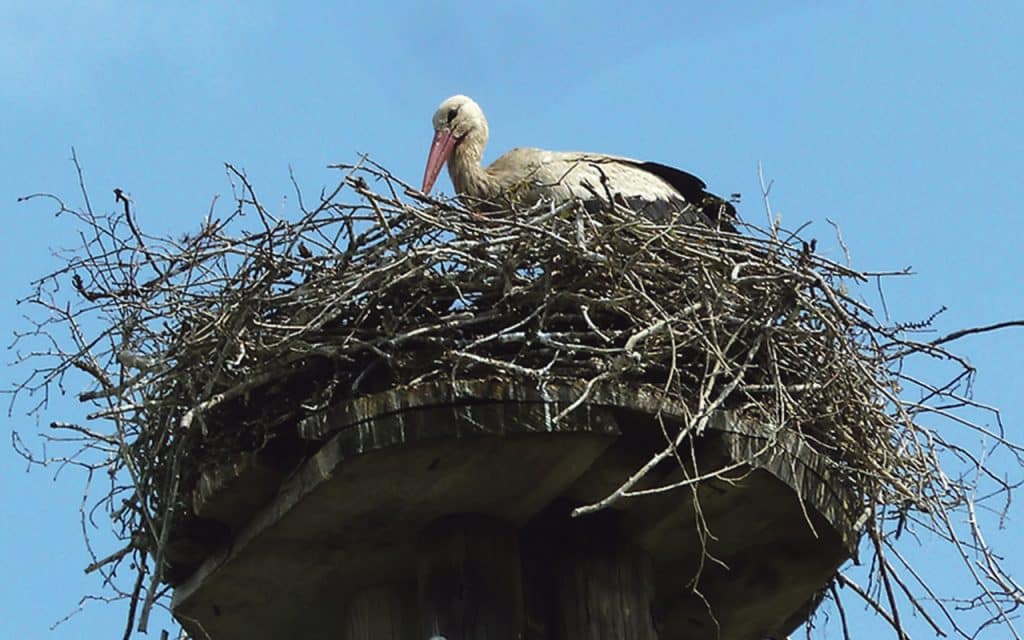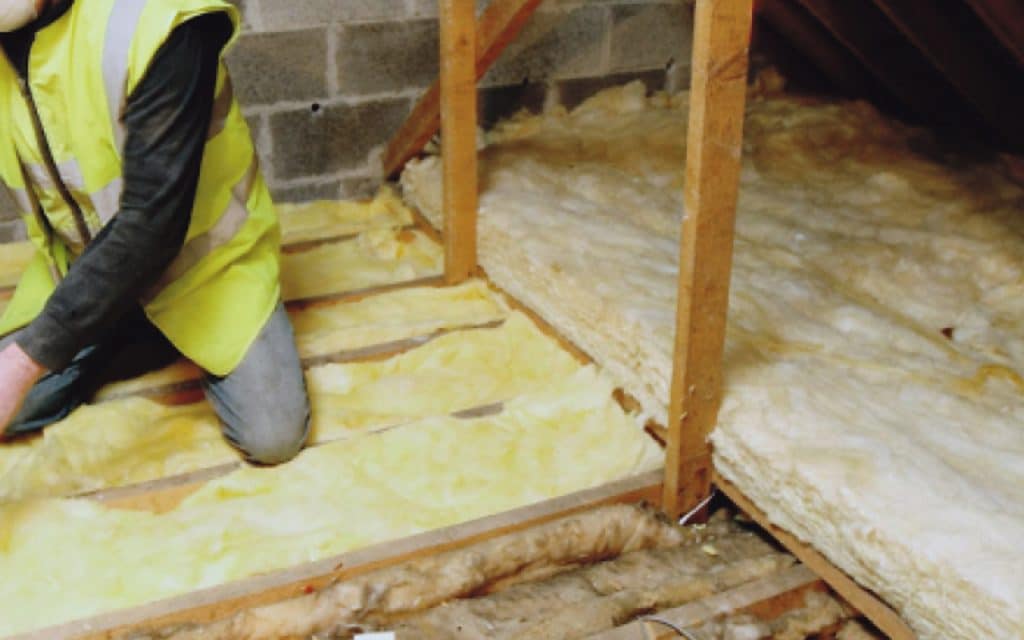Committee Member Andrea Reichstein grew up in northern Germany where the White Stork (Ciconia Ciconia) is celebrated as a very special bird. Whilst they don’t breed in Ireland, they do occasionally show up here in small numbers she writes.

According to folklore storks brought babies to households in a basket on their backs or held in their beaks. They babies would be either given to the mother or dropped down the chimney. Even today a lot of new parents in Northern Germany place a ‘KindsBaum’ (a wooden stork on a pole) in their garden to announce the arrival of a new baby. Most villages have their own highly appreciated pair of White Storks, often nesting in manmade structures (consisting of a wooden wagon wheel on a large pole) specifically prepared for them. Small information plates, often handmade, inform the curious about the breeding success of the storks over the years.
Just this year one was spotted on Valentia Island in Kerry, and shortly after in Castleisland and then in Wicklow. There was also one in Wexford, reportedly causing some traffic chaos with people abandoning their cars to see it. Another was seen in Belfast. Having this many sightings is very rare, most likely caused by unusual wind flows from the south and south-east which occurred this spring, causing the storks to overshoot their continental breeding grounds and ending up in Ireland.
The White Stork is a migratory bird that winters in Africa, south of the Sahara desert.
It breeds in Europe and also in north Africa and can be split into a western and eastern group, based on the route to its wintering grounds. The White Stork needs thermal air flow for soaring. As these do not occur over water, it avoids flying over the Mediterranean. The ‘eastern storks’ fly over the Bosphorus Strait in Turkey while the ‘western storks’ travel across the Strait of Gibraltar. The journey of around 10,000 km takes around one to one-and-a-half months with the ‘western storks’ having a shorter route, arriving earlier in their breeding grounds than the ‘eastern storks’. In recent times a growing number of ‘western storks’ are cutting their journey short and are wintering in northern Africa, or even in southern Spain and Portugal. Here they are staying close to human settlements and are feeding predominantly on open landfills. The milder winters are also causing more and more storks to stop migrating altogether and remain in their breeding grounds. In 2023, 650 pairs, one third of the Swiss population, over-wintered in Switzerland rather than migrating south.
The White Stork is an opportunistic feeder and eats earthworms, snails, lizards, snakes, frogs, small mammals such as voles, moles, mice and shrews, and also carrion. Big groups can often be seen following tractors on fields being cut for silage or ploughed, feeding on exposed earthworms, frogs and so on.
This tall bird (80cm to one metre) can reach an age of over 35 years (the oldest known stork is 39-years-old) and it breeds in open areas, preferring river floodplains and grassland lowland areas. Nests are built on ledges, solitary trees, power poles and other tall structures. The male, who arrives a few days earlier than his mate, picks a nesting site based on the availability of a suitable foraging area within 3-5 km. A stork pair will return to the same nest each year and add to it, resulting in nests that can reach heights of several metres and a weight of up to two tonnes! A change in nest site normally only happens if the male changes partner or if the site was unsuccessful. They lay two to eight eggs, which they take turns incubating. After around 30 days, the eggs hatch, and the nestlings will fledge after 58 to 64 days. Storks generally start breeding at the age of four, and initially might change partners frequently until they start breeding.
White Storks are not very vocal, they can hiss, but only at a very low volume; their main communication is through bill clattering, which can be very loud. They bill clatter to greet each other, for defence and also during their courtship ritual.
While their population is quite healthy nowadays, this was not always the case. In the 19th century, industrialisation and agricultural changes, such as the draining of wetlands and the loss of meadows, resulted in a drastic decline. Belgium, the Netherlands, Switzerland and Sweden lost their entire wild stork population between 1950 and 1990.
According to the international stork census the numbers have steadily increased since the 1984 census. The 1994/1995 census recorded 166,000 pairs, increasing to 230,000 in the 2004/2005 census. The numbers of the 2024 / 2025 census are not yet finalised but are estimated to be around 330,000 pairs. The largest population is in Poland (52,000 pairs in 2004), followed by the Ukraine (33,000 pairs in 2004).
Reasons for this population recovery are varied. For the ‘western storks’ the shorter, less dangerous migration to south Spain, Portugal and north Africa, and new food sources in the form of landfills, and also rice fields, meant their population increased quite heavily (89 per cent between the 1984 and the 1994 census). For the ‘eastern storks’ the extension of breeding range due to climate change and generally healthy habitats, especially in eastern Europe, were the main drivers for the population increase.
There are also several successful reintroduction programmes. Considered extinct in 1950, there are now around 2,000 storks in Switzerland thanks to a successful reintroduction and rewilding project.
The UK also has a successful reintroduction programme after the last and only verified record of a breeding stork pair, 600 years ago in Edinburgh. The White Stork Project started in 2006 and relies on non-flying birds from Poland, rescued following traffic accidents or collisions with power lines. These birds, donated by Warsaw Zoo, are mainly kept at Cotswold Wildlife Park. Every year, their offspring are brought to the Knepp Estate in West Sussex and Wadhurst Park in East Sussex, where they stay in pens for a few weeks until they develop site loyalty, before being released into the wild.
The first wild breeding pair in the UK for 600 years was recorded in West Sussex in 2020 as a result of the White Stork Project.
Who knows, maybe someday we will have breeding White Storks here in Ireland!
BirdWatch Ireland
West Cork Branch News
Upcoming outings being held by the Branch are:
Sunday, August 24:
Heritage Week – Family event in Timoleague
Visit the website www.birdwatchirelandwestcork.ie for more information about these events. For more information about the Branch, contact Fiona O’Neill at secretary@birdwatchirelandwestcork.ie.
FB @BirdWatchIrelandWestCork
Bluesky @bwi-westcorkbranch.bsky.social
Instagram @ birdwatch_ireland_west_cork


